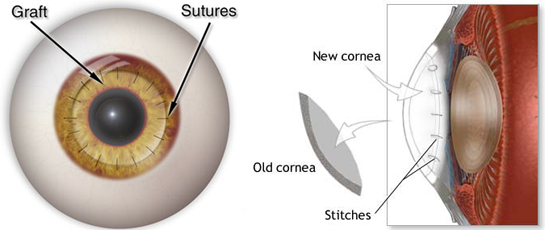
Cornea Transplant
2min ReadCorneal transplant, also known as corneal grafting, is a surgical procedure where a damaged or diseased cornea is replaced by donated corneal tissue (the graft). When the entire cornea is replaced it is known as penetrating keratoplasty and when only part of the cornea is replaced it is known as lamellar keratoplasty. Keratoplasty simply means surgery to the cornea.
The graft is taken from a recently deceased individual with no known diseases or other factors that may affect the chance of survival of the donated tissue or the health of the recipient.
Medical Uses
• Optical: To improve visual acuity by replacing the opaque or distorted host tissue by clear healthy donor tissue. The most common indication in this category is pseudophakic bullous keratopathy, followed by keratoconus, corneal degeneration, keratoglobus and dystrophy, as well as scarring due to keratitis and trauma.
• Tectonic/reconstructive: To preserve corneal anatomy and integrity in patients with stromal thinning and descemetoceles, or to reconstruct the anatomy of the eye, e.g. after corneal perforation.
• Therapeutic: To remove inflamed corneal tissue unresponsive to treatment by antibiotics or anti-virals.
• Cosmetic: To improve the appearance of patients with corneal scars that have given a whitish or opaque hue to the cornea.
Pre-operation
Optometrist must make examinations, to make sure the surgery is necessary. Then cornea must be booked through eye bank, to provide the cornea right at the surgery day.
The surgery procedure
Using microscopic medical devices, this surgery will be done, which includes replacing a circle from the centre of cornea, with the new cornea. The surgeon will make the replacement with fine stitches. The whole process will take 1 to 2 hours, and if other operations such as cataract or glaucoma is required the surgeon will take care of it, at the same time. The eye is covered with bandage when the surgery is done.
Recovery
For the first weeks after the surgery, the patient must avoid lifting heavy stuffs, storied drops will be prescribed to take for several months, to help the transplant process. Other medications to avoid inflammation and other obstacles will be prescribed. The patient must watch his eyes carefully, and wear glasses to protect the eye. If stitches has been used during the surgery, during upcoming 17 months, they will be resolved in the eye. This process will help the eye astigmatism.
Who are eligible for such operation?
• Those who have keratokonus
• Those who got inflamed or cloudy cornea
• Those who has burnet their cornea with chemicals
• Those who has cornea edema after cataract surgery
• Those who got blurry cornea because of microbial inflammations
Hospitalization
1 to 2 hours is taken for the surgery, and no hospitalization is needed




Reviews
Number of pending reviews174